The St. Louis Blues have had a strange season. General manager Doug Armstrong made waves over the summer by acquiring star center Ryan O’Reilly on the same day he picked up quality veterans Tyler Bozak and David Perron in free agency. Expectations were high for the long-suffering Blues fanbase, but then disaster struck.

The Blues stumbled out of the gate and found themselves in last place in the Western Conference as of Jan. 3, 2019. For those who follow hockey closely, if a team is out of the playoffs by American Thanksgiving, they don’t usually make the playoffs, and the Blues were well out of the race as late as January. Things got so bad that there were rumors the team might trade franchise player Vladimir Tarasenko, and a fight even broke out between teammates Robert Bortuzzo and Zach Sanford in practice.
In January, however, a few things changed for the Blues. They called up goaltender Jordan Binnington from the minor leagues on Dec. 10, 2018, replacing the volatile Jake Allen as starter. Tarasenko started putting more pucks in the net. A team that had many fresh faces from the previous season started to gel, and the wins soon followed.
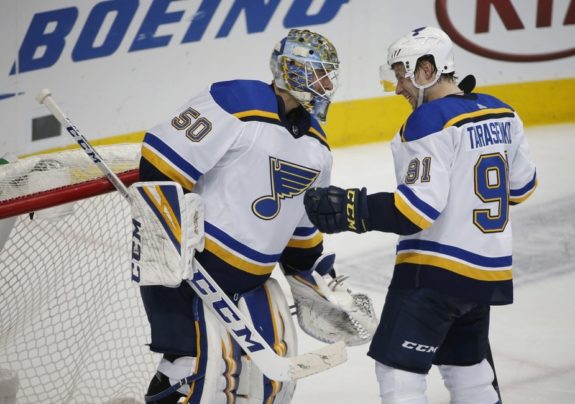
Wins snowballed into an 11-game win streak that ended in early March. The Blues are now squarely in third place in the Central Division with a chance at second or even first. They are one point away from clinching a return to the playoffs and fan excitement has returned. However, as is always the case with Blues fans, there is a fear that this will be an apparition.
When the playoffs come around, will this team be able to actually bring a Stanley Cup to this fanbase? To answer that question we need to look at the advanced statistics and explore what has changed for this team. In February, we published a piece on the reasons behind the Blues’ turnaround. This article focuses more on what those reasons mean for the Blues going forward.
Tarasenko Is Back
The Blues’ turnaround largely mirrors the turn-around in Tarasenko’s season. Trade rumors were fueled early on by a stretch of play that left much to be desired from Tarasenko. At the halfway point of the season, he was on-pace for 24 goals and 48 points over 82 games, which would be well below his last four-season averages of 37 and 72, respectively.
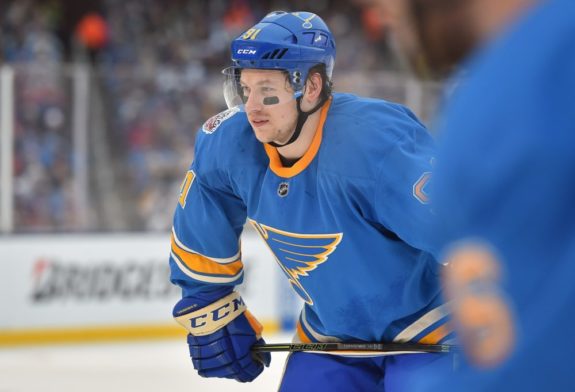
There was some thought that he was still recovering from his summer shoulder surgery after suffering an injury against the Colorado Avalanche during the final game of the 2017-18 season. There might be some truth to that. Tarasenko’s main weapon on offense is a deadly shot that he uses to snipe goals with pinpoint accuracy. A bum shoulder would certainly affect his ability to utilize his most dangerous asset.
Below is a chart using data from Natural Stat Trick that shows Tarasenko’s even-strength month-to-month Corsi for percentage (CF%) and his Goals for percentage (GF%) while he was on the ice. CF% shows the Blues’ puck possession while Tarasenko was on the ice, while GF% measured the actual goals the Blues scored versus surrendered while Tarasenko was on the ice. If an injury was limiting his shooting ability, we would expect to see diverging CF% and GF%. The injury should not have limited his ability to create opportunities as measured by CF%, but it would have limited his ability to convert on chances as measured by GF%.
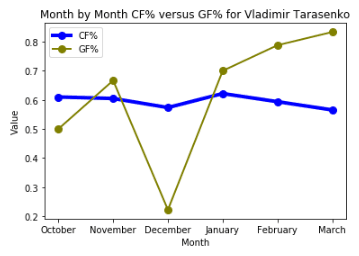
What is interesting here is that even while Tarasenko was slumping in terms of GF% from October to December, he was still controlling the play as judged by his CF%. This outcome lends some credit to the thought that maybe he was playing injured.
Tarasenko’s on-ice shooting percentage (SH%) provides further evidence that an injury was limiting his play. Tarasenko’s shooting percentage was incredibly low for his standards in November and December at 8.81 and 2.82 percent, respectively. It seems that the narrative that Tarasenko had not recovered from a shoulder surgery was largely true. Since January, Tarasenko’s shooting and goals for percentage have recovered to a level we would expect out of him.
Binnington Has Performed Remarkably Well
Binnington has been a revelation since being called up from the Blues minor league affiliate, the San Antonio Rampage. The fear, however, is that we do not have a large enough sample size of games that Binnington has played in the NHL to conclude on how good of a goaltender he will be in the future. We have seen in the past Andrew “The Hamburgler” Hammond go on a run down the stretch for the Ottawa Senators after getting the long awaited call from the minors.
Hammond has since fizzled out and is currently back in the minor leagues. Unfortunately, we really cannot conclude on whether Binnington is going to be a star or the next Hammond. However, we can look to his results in the American Hockey League (AHL) and his advanced stats this season in the NHL to get an idea of his true talent.
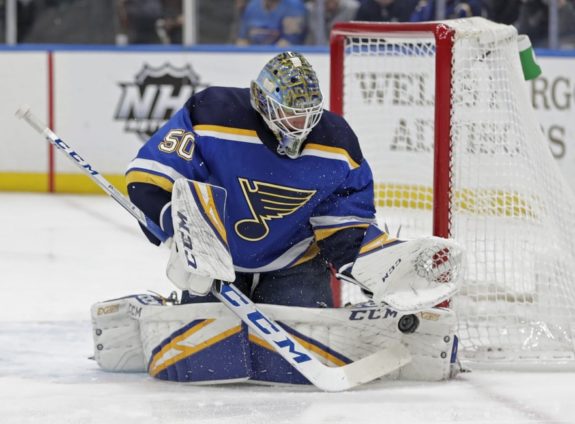
Advanced stats from the AHL are not readily available, but we can look at Binnington’s save percentage (SV%) over the past two seasons in the AHL. In 2017-18 Binnington posted a .926 SV% for the Providence Bruins, and in 2018-19 before joining the Blues, he put together a .927 SV% with the Rampage, which would have placed him fifth and second in save percentage, respectively, for AHL goalies during those two seasons.
The below chart shows Binnington’s advanced stats in comparison to Jake Allen’s this season.

Save percentage above expected, which can be seen in the far right column in the table above, is a measure that is derived from subtracting a goalie’s save percentage on unblocked shots by an expected save percentage. Expected save percentage is computed by taking into account the opposing team’s shots, shot selection, and shot distance. A goalie that has a high save percentage above expected is performing exceptionally well.
The Blues have actually done a great job for the majority of the season at limiting the amount of chances their goaltender is facing. The only thing the team really needs is a goaltender with a save percentage above expected of 0 percent, which Allen has not done this season. Binnington, however, has been saving even more than we should expect of him. While we cannot project Binnington’s future, we can be optimistic based on his AHL results and advanced statistics.
The Blues Have Finally Gelled
An NHL lineup is difficult to piece together. Fans and the media alike were praising Doug Armstrong’s moves over the summer. However, it is easy to look over the fact that there was a lot of change in the lineup, particularly on offense. Armstrong brought in O’Reilly, Bozak, Perron, Patrick Maroon and rookie Robert Thomas. In lots of cases these players had never played together before.
One hypothesis on why this team was so bad at the beginning of the season, is simply that they were not used to playing together. The chart below uses data from moneypuck.com and displays the Blues’ month-to-month Expected Goals For (xGF) and Expected Goals Against (xGA), which again takes into account shots, shot selection, and shot distance to project how many goals a team should be scoring.
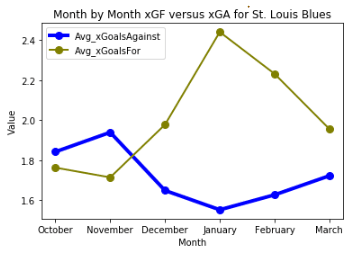
The defense has certainly gotten better since the beginning of the season, which might be because of the coaching change from Mike Yeo to Craig Berube. However, even while the Blues were playing at their worst from October to December, the defense was still limiting the opposition’s chances. Where we see the largest improvement is in xGF, which has skyrocketed. This would seem to support the hypothesis that the Blues forwards were not used to playing with one another.
What Should Fans Expect for the Playoffs?
This is a fantastic hockey team. They have the second-highest expected goals percentage (xG%) of any team in the league behind the Vegas Golden Knights. The team has rattled off victories against the Pittsburgh Penguins, the Tampa Bay Lightning and the aforementioned Golden Knights. Moneypuck.com has the Blues with the second-highest odds of any team to win the Stanley Cup after the Lightning. From an analytics perspective, the Blues are better than both the Nashville Predators and Winnipeg Jets, their likely first two round opponents in the playoffs.
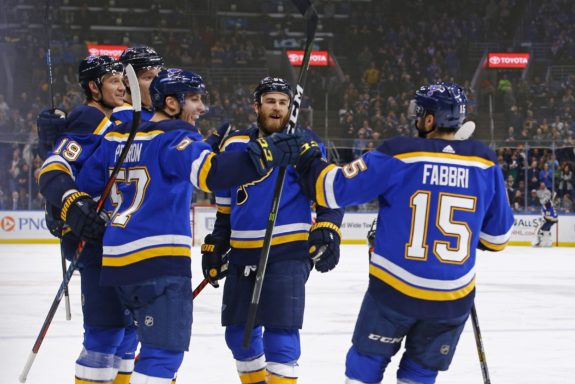
With all of that being said, the playoffs are a different animal than the regular season. Series are so short that a hot goaltender can beat the best team in the league. The Blues are relying on a young goaltender who has not proven anything in the playoffs. The team might crumple or it might go on a run. Anything can happen in Lord Stanley’s Playoffs, but Blues fans should at least allow themselves to be cautiously optimistic.